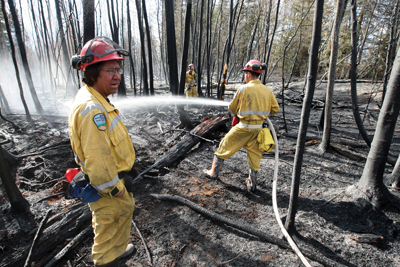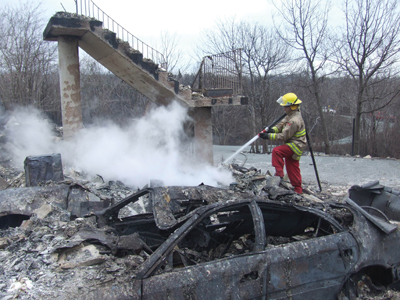
Features
Training
Wild Fire
On April 30, just 11 months after the Halifax Regional Fire & Emergency Service battled one of the worst wildland/urban interface in the province’s history, another fast-moving consumed 800 hectares of land north of Halifax and forced 1,200 people from their homes.
June 1, 2009
By James Careless
On April 30, just 11 months after the Halifax Regional Fire & Emergency Service battled one of the worst wildland/urban interface in the province’s history, another fast-moving consumed 800 hectares of land north of Halifax and forced 1,200 people from their homes.
 |
| Contract firefighters from Sucker Creek First Nation near High Prairie (front to rear) Vincent Willier, Johnny Calliou and Tyler Willier battle a wildfire north of Josephsburg, Alta., on May 6. (Photo by John Lucas, Edmonton Journal) |
The Halifax-area fire, fuelled by debris on the ground from Hurricane Juan in 2003, was the first of several such fires that last week of April and one of thousands that will burn more than 2.5 million hectares this year.
As Canadian communities expand, fires that used to burn deep in the country’s forests are encroaching on subdivisions that are being built deeper into the woods, away from bright lights and big cities. As many Canadian firefighters know, this suburban sprawl causes major headaches.
Two of the worst recent urban/interface fires – the June 2008 Lake Echo/Porters Lake blaze around Halifax that consumed 2,500 hectares and sent 30,000 people out of their homes, and the devastating 2003 Okanagan Mountain Provincial Park blaze on the outskirts of Kelowna, B.C. – provided valuable lessons for firefighters.

|
|
| Firefighter Steve Gallant of Station 58 (Lakeside) wets down the still smouldering ruins of this home on the third day of the fire. (Photo courtesy Halifax Regional Fire & Emergency Services) |
■ Encroachment
Kelowna Fire Chief Rene Blanliel says drought conditions, high winds and the fuel load created by beetle-killed ponderosa pine turned a 10-hectare fire caused by a lighting strike to grow into a Rank 6 firestorm that demolished 27,000 hectares.
“It got to the point that all we could do was get everyone out of the firestorm’s path, then see what could be salvaged afterwards,” he says.
The Okanagan fire destroyed 239 homes. The 60 fire departments, 1,000 firefighters,1,400 armed forces troops and five water bombers were largely helpless in the face of one of Canada’s worst wildland/urban interface fires.
Like this spring’s Halifax fire, most springtime fires are wildland/urban interface fires caused by human activity, says Jim Murphy, a fire advisor for the Ontario Ministry of Natural Resources.
“The reason urban/rural interface fires are often devastating is because this is where people meet the wildland areas; more and more intermixed areas are cropping up,” he says.
“All areas are dead, cured fuel in spring so there is lots of fuel for fire to burn. Also, there is often little time to react; usually more defensive strategies are needed instead of offensive.”
Roy Hollet, deputy chief director at Halifax Regional Fire and Emergency Services, knows wildland/urban interface fires only too well. He says interface fires are common in the region because of the urban sprawl.
“These homes are located in the wildland/wood and in most cases the trees/brush is allowed to grow too close to the home. In this case, once a wildland fire starts, it is able to spread to residential areas (pending terrain and weather conditions) with relative ease.” (See Trainer’s Corner )
Wildland/urban interface fires are tough to fight because they happen in areas without hydrants, and are often tough to get to. But like the Halifax fire in late April/early May, the biggest challenge is that most of these fires happen in grassy areas, or fine fuel areas, says Nolan Shortt, a fire advisor with Ontario ministry.
“Fine fuel fires tend to spread fast and react quickly to changes in wind speed and direction,” he says. “It is a possibility that by the time the fire department arrives the fire could have already spread to values [homes and other buildings].”
■ Lessons learned
Since fighting urban/rural interface fires is so difficult, seasoned agencies such as the Kelowna Fire Department spend a lot of time trying to reduce the threat.
“We work hard to educate homeowners as to the importance of removing deadwood and brush from their properties,” says Chief Blanleil. “We also urge new home builders to keep their sites as clear of debris as possible, and to design their developments to allow easy access of fire equipment and evacuation of residents.”
One effective educational tool is the FireSmart booklet developed by Partners in Protection, which is available for free at www.partnersinprotection.ab.ca/downloads/ . (See also www.getprepared.ca )
“The biggest factor that contributes to the interface fires is the lack of knowledge,” says Shortt.
Educated homeowners who reduce the risk of interface fires by keeping the fuel load down certainly helps but interface fires will still occur and firefighters will still have to put them out. And that means urban fire departments need to train for wildland/urban interface fires.
Just like live fire training for structural fires, it’s imperative that firefighters get out into the wildland/urban interface to find out what they may be up against, including bad roads and no municipal water.
“If you do not drive the back roads, how can you know where to go?” says Don Henry, who chairs the International Association of Fire Chiefs’ apparatus maintenance section committee.
“Just as you need to drive the city to understand the roads and obstacles that this territory entails, so you need to drive the urban/rural interface to know this area well when you do have to respond.”
Henry also notes that trucks with high bumpers, four or six-wheel drive and transmissions with deeper reductions are needed to operate off road and in hilly terrain.
He also recommends using compressed air foam for wildland/urban interface fires.
“If you thought that water put out fire better then dirt, then you should see what compressed air foam does,” Henry says. “People often think that CAF is only for big city departments, but its true value is with small rural departments that have a water shortage. Yes, compressed air foam is a bit more complicated both from an operational and maintenance point of view, but when it comes to fighting urban/rural interface fires, it’s worth it.”
Halifax’s Deputy Chief Hollet recommends that city firefighters take courses on fire behaviour, fire safety and planning to prepare for wildland/urban interface fires.
“Excellent prevention and education strategies should be implemented to prepare people prior to an event. It is also important to have an emergency plan in place,” he says.
Hollet notes that the wildland firefighting environment is different than structural fire and includes hazards such as:
| • | the ease with which a wildland fire can turn back on itself and surround a fire crew; |
| • | the speed at which a wildland fire can move and very easily overcome a ground crew; |
| • | the heat intensity that a wildland fire can have, and the radiant ground heat; |
| • | the hazards of being in the woods (getting lost and wild life). |
| • | the risks involved when water bombers are overhead. |
■ Innovations
|
||||||||||||||||||||||
In Ontario, the Ministry of Natural Resources has established a system under which local departments can call in water bombers from the province. As well, the ministry has created Mobile Values Suppression Units, essentially cargo trailers loaded with sprinklers and other fire fighting equipment designed to protect cottages, subdivisions, tourist lodge/outpost camps and cut wood, according to Nolan Shortt.
In Halifax, firefighters took matters into their own hands and developed a skid that slides into the back of a three-quarter ton truck, says Mike LeRue, a division chief with Halifax Regional Fire & Emergency Services.
The skid is fitted with a 400-gallon water tank and a 20-hp pump and turns the truck into an instant quick-response vehicle.
“We also prepare an urban/rural firefighting kit reloaded on a pallet, that contains everything we need for the job,” LeRue says. “When such a fire strikes, we just load it and go.”
A key component of effective wildland/urban interface fire management is dealing with the public. Jim Murphy, the Ontario fire advisor, recommends that regions have haver media ads ready for emergency situations and identify people who are good at dealing with public when emergencies occur.
Deputy Chief Hollet says the key to handling media enquiries and keeping homeowners informed is open, honest communication.
“Your media representatives need to be professional, empathic, caring, helpful and – again – honest.”
Hollet says spokespeople for the department must provide the most up-to-date information possible and be prepared to answer an array of questions. He recommends bringing maps outlining the fire area and, if possible, aerial photos and anything to maintain the media’s co-operation.
“It is also very important to keep the area residents updated before going to the media,” he advises. “It is best that area residents (especially evacuees) hear the truth from the fire spokesperson in person than to hear news from the media. You need the residents’ trust in order to do your job properly.”
To effectively fight wildland/urban interface fires, departments need to educate the public, minimize the risks and train their people properly. Still, in worst-case scenarios such as the 2003 Okanagan Mountain Provincial Park firestorm, there are times when a strategic retreat is the most appropriate response. •
Print this page